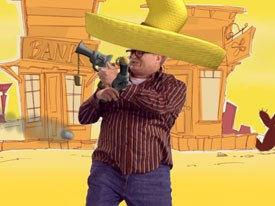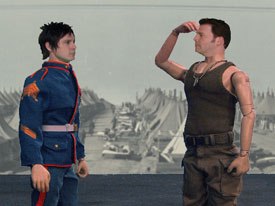In this first installment, Greg Singer walks the beat of the Green Screen Show to witness the blood, sweat and tears in bringing the new television series combining live action and animation to life.

Drew Careys Green Screen Show has been in the making for hmm, doing the math in my head three months or so. I have been invited to witness the backstage goings-on for the last couple of weeks, and the producers, directors and managers have generously welcomed me in my attempts to understand the show, and thereby to report its inner workings to you, dear reader.
This behind-the-scenes look into the production is not a diary of everyday events, so much as a series of articles glimpsing the process of creating the Green Screen Show. Acme Filmworks is the studio producing the live-action and animation, and The WB Television Network is the distributor of the show, premiering October 7.
With that as preface, allow me to briefly and properly set the stage. Following on the heels of the recently departed Whose Line Is It Anyway? and successfully parrying the adage that time wounds all heels Drew Careys Green Screen Show is more of the same, only better. I can say it honestly, because, in my unbiased estimation of unfolding cosmic history, most live-action entertainment is improved upon by animation. That is the premise of the show: improvisational comedy is taped in front of a live audience on a greenscreen set, and then, bippity boppity boo, the action is enhanced with animated environments and props.
Okay, its not quite that straightforward, but we will cover the details in subsequent articles. Still, the result is visually appealing, it embiggens the comedy (I encourage everyone to make up words, as appropriate), and mimesis (which is not, strictly speaking, a made-up word, but means the imitation or representation of things) looks so much better through the imaginative lens of animation.
This is, in a nutshell, what makes the Green Screen Show so innovative and unique. The fact that there is now a venue on primetime television for a variety of animation styles and techniques, from directors from around the world, makes my heart flutter with giddy anticipation. The executives at The WB seem to agree. During a phone meeting earlier in the week, they effused to Acme, You have done a great job. The show is incredible, its awesome. Its fun to see different animation each time.

Fun and Games
Of the 150 improvisational skits (or games) that were originally taped, there are 50 or so that are being edited and used for the first 12 episodes of the season. With about four games per episode, each averaging about five minutes, not including bumpers and transitions, were talking roughly four hours of animation that Acme Filmworks is producing. Given the looming airdate, the turnaround time on some of the games is as little as four weeks. Industry insiders have whispered that such a tight schedule is crazy, and that the studios involved deserve kudos if they can do it.
They are, of course, pulling it off. Already there are 40 directors (plus or minus) working on one or more of the games. A big consideration is timing. Though many animators are interested to participate, some just dont have the time to work on the show. Even so, Chris Hinton (Montreal), Brown Bag Films (Ireland), Bill Plympton (New York), Bibo Films (France), Eric Goldberg (Los Angeles) and Oniria Productions (Luxembourg), among others, are managing to find the elbow room among their other commitments to pull together some funny, creative stuff.
As of this writing, there are three games yet to be cast. Proposals to animate are still coming in. On one typically sunny afternoon, there was an informal meeting between Tom Knott of Acme Filmworks and a prospective director from Drew Careys native Ohio. Tom is one of those affable and quiet fellows who has been so long in the animation business that very little impresses him anymore though, God willing, there is a work-in-progress sitting unannounced on some workbench or animation disc somewhere, waiting to impress him.
Once upon a time, Tom served as the coordinating director of the Ottawa International Animation Festival, before putting in several good years at Warner Bros. Animation. Now, he is helping Acme to recruit an impressive crew for the Green Screen Show that would make any animation enthusiast proud. As the visiting director reviewed some sample clips, Tom explained that he is looking for work that is less Disney, and more designy.
The quality of the animation being produced, given the budget and schedule, is top-notch by television standards. Screen Novelties, for example, is a small Los Angeles studio a hidden treasure or hole-in-the-wall, depending on your perspective that is doing stop-motion animation for one of the games. Operating near the distractingly hip Melrose Ave., animators Seamus Walsh, Chris Finnegan and Mark Cabellero have just concluded a three-week marathon of animating toy soldiers, something on the order of 12 seconds per day. (For the uninitiated, under normal circumstances, stop-motion animation might average eight seconds per day.) With other high-profile projects feathered into their caps, the puppet makers and movers of Screen Novelties are clearly on the up and up.

The general process for how things happen is that the live-action coverage of the improv is honed into a neatly paced skit, retaining the especially funny parts (as guesstimated by the producers and evidenced by the audiences laughter). Naturally, The WB signs off on the edited live-action, and then potential directors are shown clips to see if any of the games appeal to them. The directors pitch some concept sketches, and, if their idea looks promising, they are given the a-okay to work on a game. The whole process is facilitated courtesy of a production Website, where concept artwork, treatments, storyboards, animatics, rough tests and so on, are uploaded. The producers and directors of Acme Filmworks can immediately review the materials and offer feedback, and everything, snap-snap-snap, continues to move forward.
In fact, during one meeting, the titular Carey seemed genuinely impressed by the progress of the shows accompanying animation. In reviewing one game in production based on Shakespearean themes, proposed by Janet Perlman of Montreal (one of the few women directors, as an aside), Drew laughed very easily and fully. As I sat there, playing the part of unassuming observer, he then asked me, So, what do you think?
Its good, I answered. Drew smiled, slapped a palm to the table, and happily reported, No, its great!
A few days later, a similar exchange occurred between me and Acmes exec producer Ron Diamond. When asked for my impression of a snippet that had been uploaded by one of the participating studios, I echoed the sentiments of line producer Prudence Fenton that the animation was one of the outstanding pieces. Commenting on the clips that have come in, Diamond confidently added, Theyre all outstanding pieces.
One of the in-house animation directors of the Green Screen Show, dapper and quick-witted Scott Ingalls, remarked on seeing a proposed storyboard sequence, There is so much creativity in the world. More people need to go into waitressing, to leave more room for us.
The live-action improv offers one layer of humor, and the embellishment of animation offers another. While the animation is overlapped with the improv in its own time and way, the artists have to remember not to telegraph a joke before it is introduced by the actors.

During the assessment of one games rough animation, to put things in perspective, Scott reminded everyone, Keep in mind were talking about a cartoon banana exploding with sound effects made by a woman offstage. I think we can allow for some creative latitude.
For another game, the animation was so well integrated with the live-action, the network was worried it may have dimmed how smart the original improv was on stage. Exec producers Diamond and Robert Morton couldnt do much about that, except to say thanks. Its always fun to get network notes, especially those dealing with standards and practices. In addition to concerns about the artistic expression of bugging eyeballs, disembowelment, and the like, one helpful note said, We offer caution on the elephant poop. It should play dry and firm.
Drawn Together
For all the attention to detail, no aspect of production is too small to go untouched. The first three episodes are among the most crucial to the success of the show, because the network may decide on the back nine (whether to renew the show during the second half of the season) within weeks of its premiere. Also, there needs to be three strong episodes during sweeps (more TV lingo, referencing late October and early November). Everyone wants the order of the episodes, and the choice of games within each episode, to be just right.
Acme Filmworks has had extensive renovation to accommodate the production in its garden suites, and the new studio looks lean and functional. During my second day there, a memo had made the rounds for people to bring in their personal things, even if only to smarten up the place for a TV Guide shoot that was happening on the following day. Apparently, Drew Careys Green Screen Show is recommended as one of a handful of new programs to keep an eye on for the coming fall season.

Jeff Davis, one of the shows improv actors, dropped by the studio one day and said how exhilarating it was to see everything coming together. He commented how the opening title sequence is slick, and how it very succinctly explains (in 30 seconds) what the whole show is about without having to talk down to anyone. Watching a pencil test, Jeff said he was honored to be in a Bill Plympton cartoon, and he felt that The WB needs to promote the show, get behind it, and allow it time to find its audience. He said, Theres no way people wont stop to watch this, if they are flipping through channels...
Jeff asked Diamond if the animators are enjoying working on the games. Without question, very much so, Diamond answered. While many of the animators have worked on projects combining live-action and animation, they usually dont have such quality material to work with. Unlike some commercial work, the animators can let their imaginations run wild, and its fun to see what surprising and unexpected things come back.
Producer Fenton says that the animators are banging stuff out, but not fast enough for The WBs promotions department. Seeing a clip playing on Fentons computer, a coworker quipped, Oh, is that what were doing here? I thought we were working in a shoe factory. Its good for the studio employees to have perspective on what they are creating, and when everyone crammed into a small screening room one early morning to watch some of the clips, there was encouraged laughter and applause.
In addition to the heartache and hustle of production, in the coming weeks we will look at some of the animation directors involved in the show, as well as the process for how it is all being done. Stay tooned.
For disclosure: Green Screen Show exec producer Ron Diamond is also the founder and co-publisher of Animation World Network.
Greg Singer is an animation welfare advocate, eating in Los Angeles.







